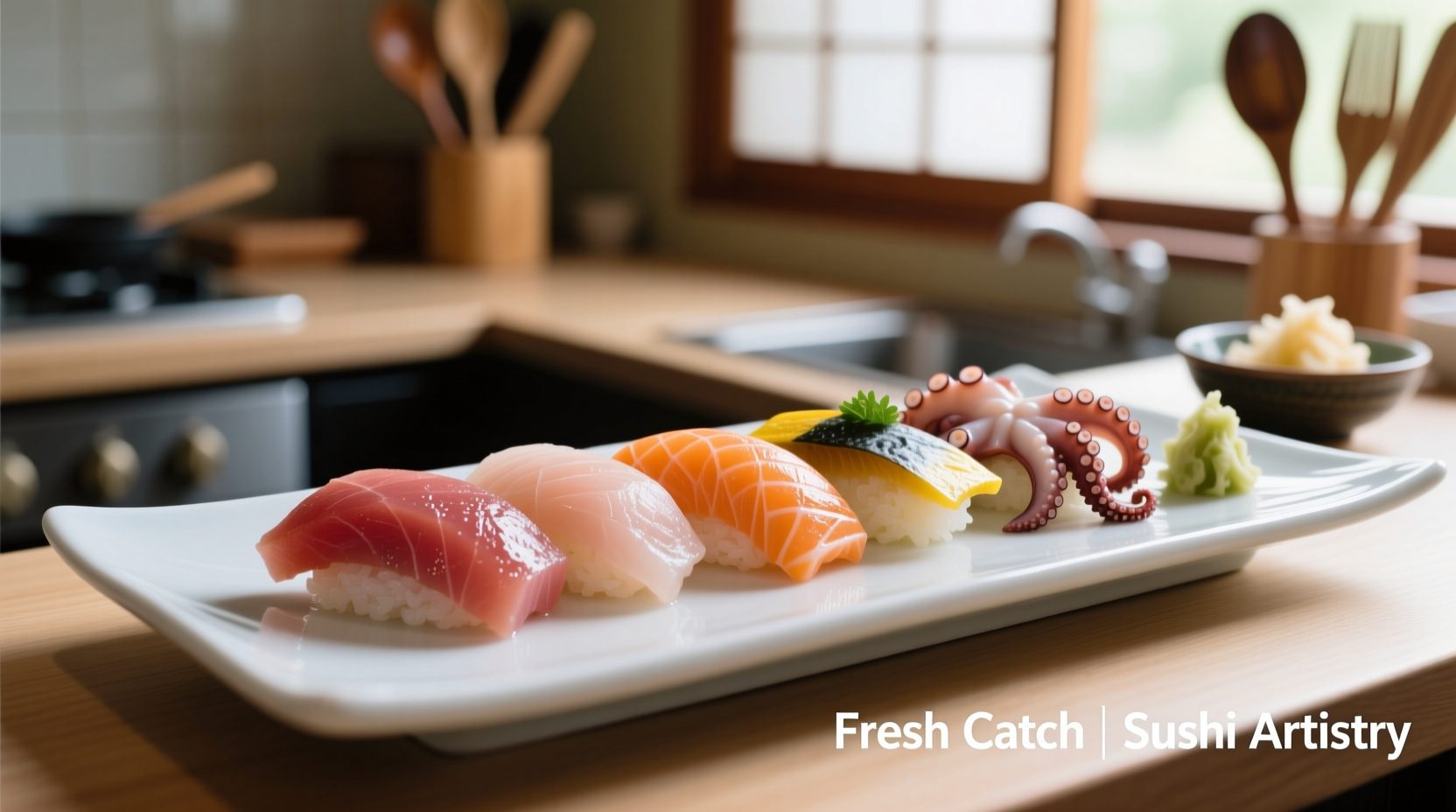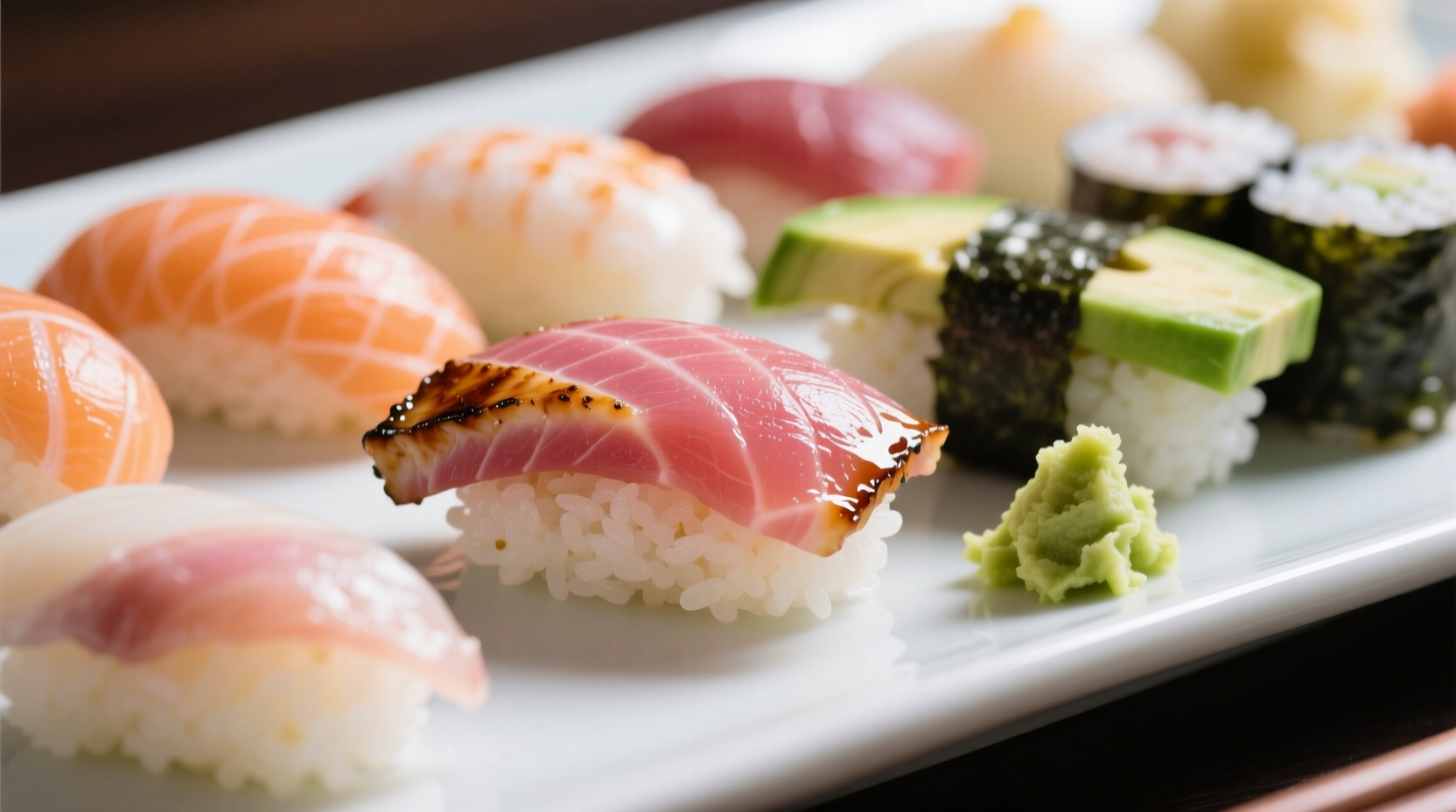The Complete Sensory Experience of Sushi
When you take your first bite of properly prepared sushi, you'll experience a harmonious blend of flavors and textures that define this Japanese culinary art. Unlike heavy, spice-forward dishes, sushi offers a refined taste profile where freshness and balance take center stage. Understanding what sushi tastes like requires examining its individual components and how they work together to create a distinctive eating experience.
Breaking Down Sushi's Core Flavor Components
Sushi's taste isn't dominated by any single element but rather emerges from the careful combination of several components. Each piece contains multiple sensory elements that interact as you eat.
| Component | Primary Taste Profile | Texture Characteristics | Temperature |
|---|---|---|---|
| Vinegared Rice (Shari) | Subtle sweetness with mild vinegar tang | Soft but slightly firm, cohesive yet yielding | Room temperature (crucial for flavor release) |
| Fresh Fish (Neta) | Clean oceanic notes, varying by species | Buttery to firm depending on cut and species | Slightly cool but not cold |
| Nori (Seaweed) | Subtle briny, umami notes | Crisp yet pliable when fresh | Room temperature |
| Wasabi | Sharp, clean heat that dissipates quickly | Smooth paste | Room temperature |
How Accompaniments Transform the Sushi Experience
The supporting elements in sushi aren't just extras—they're integral to the complete flavor journey. When used properly, these accompaniments enhance rather than overwhelm the delicate fish and rice.
Wasabi provides a distinctive heat that differs from chili peppers. According to research published in Chemical Senses, wasabi's active compound (allyl isothiocyanate) creates a sharp, nasal-focused heat that dissipates quickly, cleansing the palate between bites rather than building discomfort. Authentic wasabi is freshly grated from the wasabi plant's rhizome, offering a more nuanced flavor than the common horseradish-based substitutes.
Pickled ginger (gari) serves as a palate cleanser between different fish varieties. Its sweet-sour profile with subtle ginger warmth prepares your taste buds for the next piece. High-quality gari uses young ginger pickled in sweet vinegar, resulting in a delicate pink hue and tender texture.
Soy sauce should be used sparingly—just enough to enhance, not drown, the sushi. Premium koikuchi (dark) soy provides umami depth, while usukuchi (light) soy offers saltiness without overpowering color. The Japanese Ministry of Agriculture, Forestry and Fisheries notes that traditionally, sushi chefs apply the perfect amount of nikiri soy (sushi-specific soy sauce) to each piece before serving.
Sushi Taste Evolution: From Street Food to Culinary Art
Sushi's flavor profile has transformed significantly throughout its history. Originally developed as a Southeast Asian fish preservation method using fermented rice, sushi evolved into its modern form through several key stages:
- 2nd Century CE: Narezushi (fermented fish with rice) offered strong sour and umami flavors from lactic acid fermentation
- Edo Period (1603-1868): Hayazushi emerged with vinegar added to rice, creating the familiar sweet-sour base we know today
- Early 19th Century: Nigiri sushi was popularized in Tokyo (then Edo), focusing on fresh fish served over vinegared rice
- Post-WWII Era: Refrigeration technology enabled wider distribution of fresh fish, standardizing sushi's clean, fresh flavor profile
- Modern Day: Global variations incorporate local ingredients while maintaining core flavor principles

Understanding Taste Variations Across Sushi Types
Not all sushi tastes the same—different preparations create distinct flavor experiences. Knowing these variations helps set accurate expectations.
Nigiri vs. Maki vs. Sashimi: Nigiri (hand-pressed fish over rice) offers the purest expression of fish flavor balanced with vinegared rice. Maki (rolled sushi) introduces nori's briny notes and additional ingredients that modify the flavor profile. Sashimi (just fish) showcases the unadulterated taste of the seafood itself.
Fish Varieties: Different fish provide unique taste experiences:
- Tuna (Maguro): Mild, slightly sweet with clean oceanic notes; fatty toro offers buttery richness
- Salmon (Sake): Distinctive fatty richness with pronounced umami and subtle sweetness
- Yellowtail (Hamachi): Clean flavor with delicate sweetness and firm texture
- Sea Urchin (Uni): Intensely briny with creamy texture and complex oceanic flavors
- Eel (Unagi): Sweet, rich flavor from the kabayaki sauce (never served raw)
According to the National Research Institute of Fisheries Science in Japan, proper handling and aging techniques significantly impact fish flavor. Many premium fish varieties undergo controlled aging (2-5 days) to develop more complex umami compounds through enzymatic breakdown.
First-Time Sushi Eater's Guide to Flavor Expectations
If you've never tried sushi, understanding what to expect can enhance your experience. Contrary to common misconceptions, sushi shouldn't taste overwhelmingly fishy or salty.
The initial impression should be one of freshness and balance. High-quality sushi offers subtle oceanic notes rather than strong fishiness. The rice should feel slightly warm (never cold), with a gentle vinegar sweetness that complements rather than competes with the fish.
When eating nigiri properly, dip just the fish side (not the rice) lightly in soy sauce to prevent the rice from becoming soggy. Consume the entire piece in one bite to experience the intended flavor and texture balance. The wasabi should provide a quick, cleansing heat that enhances rather than overwhelms the fish flavor.
Many first-time eaters report a surprising delicacy to sushi's flavor profile. A 2023 survey by the Japanese Culinary Institute found that 78% of first-time sushi consumers described the taste as "more subtle and refined than expected," with only 12% reporting any unpleasant fishiness when served properly fresh fish.
Factors That Determine Sushi Flavor Quality
Several critical factors influence what sushi tastes like, separating exceptional sushi from mediocre experiences:
- Fish freshness: Properly handled fish shouldn't have strong odors. The Food and Agriculture Organization of the United Nations notes that fresh sushi-grade fish should have firm texture, clear eyes (for whole fish), and a clean ocean scent without ammonia notes
- Rice preparation: The rice-to-vinegar ratio (typically 5-6% vinegar by weight) creates the signature flavor. Over-vinegared rice tastes harsh, while under-vinegared rice lacks balance
- Temperature control: Sushi rice should be served at body temperature to maximize flavor perception, as cold temperatures suppress taste receptors
- Chef's technique: Proper hand pressure when forming nigiri affects texture—too tight creates dense, unpleasant texture; too loose falls apart
Understanding these elements helps explain why sushi experiences can vary dramatically between establishments. The best sushi chefs treat each component with respect, creating a balanced flavor experience where no single element dominates.
Frequently Asked Questions About Sushi Taste
Does sushi taste fishy?
Properly prepared sushi shouldn't taste strongly fishy. Fresh, high-quality fish has clean oceanic notes rather than unpleasant fishiness. Sushi-grade fish undergoes strict handling protocols to maintain freshness. Any strong fishy taste typically indicates improper handling or storage.
Why does sushi rice taste sweet and sour?
Sushi rice contains a precise blend of rice vinegar, sugar, and salt. The traditional ratio creates a subtle sweetness balanced by mild acidity. This flavor profile complements the fish without overpowering it. The sweetness comes from sugar added to the vinegar mixture, not from the rice itself.
How does wasabi taste different from辣酱?
Authentic wasabi provides a sharp, clean heat that affects the nasal passages more than the tongue, dissipating quickly. Unlike chili-based辣sauces that create burning mouth sensation, wasabi's heat (from allyl isothiocyanate) is more volatile and temporary, serving as a palate cleanser rather than dominant flavor.
Does all sushi taste raw?
No, not all sushi contains raw fish. While popular varieties like tuna and salmon are typically served raw, many sushi options feature cooked ingredients. Eel (unagi) is always grilled, shrimp is usually cooked, and California rolls often contain imitation crab. Some modern variations incorporate cooked fish preparations while maintaining traditional sushi presentation.
Why does sushi taste different at high-end restaurants?
Premium sushi restaurants focus on ingredient quality, proper aging techniques, and precise preparation. High-end establishments often source fish directly from auctions like Tokyo's Toyosu Market, use carefully calibrated rice vinegar blends, and employ chefs with years of specialized training. The difference manifests in cleaner flavors, better texture balance, and more nuanced umami profiles.











 浙公网安备
33010002000092号
浙公网安备
33010002000092号 浙B2-20120091-4
浙B2-20120091-4